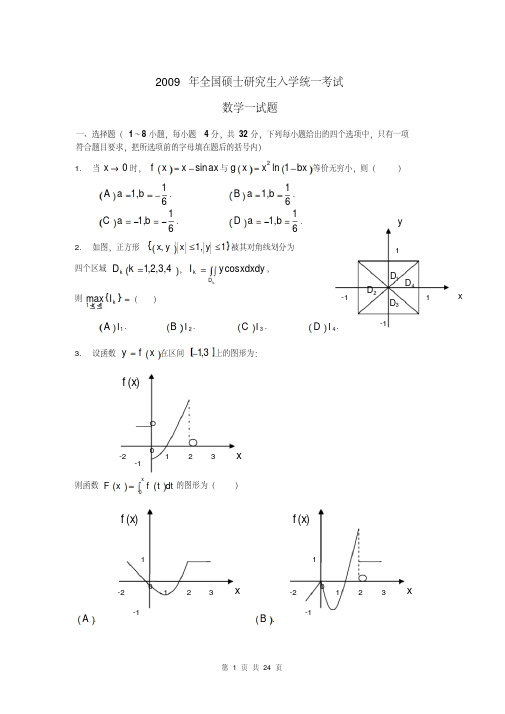中国科学院2009年秋季博士研究生入学考试部分试题及答案
中国科学院(中科院)考博历年试题汇总

中国科学院(中科院)考博历年试题汇总中科院发育遗传所2002生物化学(博士)注:请将试卷写在答题纸上;不用抄题,但要写请题号;草稿纸上答题无效。
一、名次解释:(20分)二、以动物细胞或植物细胞为例说明细胞中的膜结构及其功能。
(12分)三、在研究位置基因的功能时往往采用推定的该基因所编码的氨基酸序列与已知功能的蛋白质的氨基酸序列比较来推断,你认为这种比较应采用什么原则?为什么?(12分)四、真核基因在原核细胞中表达的蛋白质常常失去生物活性,为什么?举例说明。
(12分)五、简述信号肽的结构特点、功能和从蛋白质产物中切除的机理。
(12分)六、分子筛、离子交换和亲和层析是三种分离、醇化蛋白质的方法,你如何根据所要分离、纯化的蛋白质的性质选择使用。
(12分)七、酶联免疫吸附实验(ELISA)的基本原理是什么?如何用此方法检测样品中的抗原和抗体?(12分)八、某一个蛋白,SDS凝胶电泳表明其分子量位于16900于37100标准带之间,当用巯基乙醇和碘乙酸处理该蛋白后经SDS凝胶电泳分析仍得到一条带,但分子量接近标准带13370处,请推断此蛋白质的结构?为什么第二次用前要加碘乙酸?(8分)中科院发育遗传所2000-2001生物化学(博士)2000年博士研究生入学考试生物化学试题1.酶蛋白的构象决定了酶对底物的专一性,请描述并图示酶与底物相互关系的几种学说。
(20分)2.什么是DNA的半保留复制和半不连续复制?如何证明?真核细胞与原核细胞的DNA复制有何不同?(20分)3.概述可作为纯化依据的蛋白质性质及据此发展的方法。
(20分)4.简述酵解和发酵两个过程并说明两者的异同。
(15分)5.吃多了高蛋白食物为什么需要多喝水?(10分)6.在非极端环境的生物体中是否存在氰化物不敏感的呼吸作用?如果有,其可能的生物学意义是什么?(5分)以下两题中任选一题(10分)7.概述植物或微生物细胞感应(应答)环境刺激因子(如养分缺乏、热、冷、干旱、强光等)的可能的生物化学过程模式。
海洋所考博试题

当时得到的试卷,希望对大家有用中国科学院研究生院2008年招收攻读博士学位研究生入学统一考试试卷科目名称:生态学考生须知:本试卷满分为100分,全部考试时间总计180分钟。
******(试题内容)一、试述海洋生态系统类型,以及它们各自的基本组分、结构和功能。
(10分)二、简述海洋初级生产力、新生产力、再生生产力的涵义,它们之间的关系及其研究方法。
(15分)三、全球变化的核心问题是什么?海洋生态系统对全球碳平衡的作用如何?(10分)四、限制海洋自养生物生长的营养盐和微量元素主要有哪些?举例说明海洋中生源要素的循环规律和作用机制。
(10分)五、有研究者发现:南海开阔海区叶绿素a和初级生产力的垂向分布峰值常出现在次表层,试分析其原因和调控机制。
(15分)六、简述现代生态学的主要研究内容与今后发展趋势,你最感兴趣的领域是什么,打算怎么做?(10分)七、请选择以下命题之一(题目可在此命题基础上自行细化),写一篇学术文章或基础研究项目申请书(30分):1.河口海湾浮游生态动力学2.珊瑚礁样带生物多样性与气候变化关系3.海洋微食物网结构与功能作用4.人类活动影响下近海环境演变与生态安全中国科学院研究生院2009年招收攻读博士学位研究生入学统一考试试卷科目名称:生态学考生须知:1.本试卷满分为100分,全部考试时间总计180分钟。
2.所有答案必须写在答卷纸上,写在本试卷纸或草稿纸上一律无效。
一、什么叫新生产力和再生生产力?试述南海开阔海域初级生产力的垂向分布特点。
(12%)二、为什么说海洋是地球上最大的生态单位?联系海洋主要分区说明海洋在纬度、深度和从近岸到大洋等三大环境梯度特征。
(10%)三、简述赤潮发生的原因、消长过程与预防对策。
(10%)四、试述海洋生物泵,并说明海洋生物泵(包括碳酸盐泵)对吸收大气CO2、缓解全球温室效应的作用机理。
(10%)五、铁是哪些海区浮游植物生长繁殖的限制元素?说明海洋中铁的主要来源,它在海洋透光层中的供应特点与N、P营养盐有什么差别?(10%)六、什么叫海洋微型生物食物环?它在海洋生态系统的能量流动和物质循环中有哪些重要作用?(10%)七、海底热液口的环境和生物组成有哪些特征?其生物群落的有机物质生产过程与光合作用有什么不同?(10%)八、试写一份生态领域的基础研究项目申请书,内容包括题目、立项依据、研究内容与目标、拟解决的关键科学问题、主要创新点、技术路线、预期成果等。
2009年硕士研究生入学考试试题

2009年硕士研究生入学考试试题一:名词解释1:粗差2:系统误差3:偶然误差4水准测量的原理5:验潮站6:4D产品7:数字高程模型8:等高线3-8一定是,1,2好像有一个,不确定。
其它的就想不起来了。
二:简答题1:偶然误差的特性2:GPS测量中的误差来源3:光电测距仪测定的距离进行哪几方面的改正计算4:计算机中的坐标与实地中的坐标如何转换5:三角高程测量的方法1-4一定是,第5个就是两种情况之一三:论述题(5选2)1:各种坐标系的定义;原点,X轴,Y轴是如何规定的。
2:结合所学专业,论述本专业的现状和发展前景。
一、中国遥感技术应用现状1957年第一颗人造地球卫星升空标志着人类进入了太空时代,从此人类以崭新的角度开始重新认识自己赖以生存的地球。
空间信息技术是本世纪60年代发展起来的一门新兴的科学技术,遥感技术,包括地理信息系统和全球定位系统,则是对地观测的重要手段。
中国的遥感技术从70年代起步,经过十几年的艰苦努力,已发展到目前的实用化和国际化阶段,具体表现在具备了为国民经济建设服务的实用化能力和全方位地开展国际合作使其走向世界的国际化能力。
1为国民经济可持续发展提供科学的决策依据2具有对重大自然灾害灾情进行动态监测和评估的能力中国是自然灾害频繁且严重的国家,每年因灾害所造成的损失高达上千亿元人民币。
对重大灾害进行动态监测和灾情评估,减轻自然灾害所造成的损失是遥感技术应用的重要领域。
3利用遥感技术进行农作物估产和林业资源调查4地质矿产资源遥感调查此外,近年来发展起来的干涉测量雷达技术已经在三峡大坝等大型工程的环境监测和油气区地面沉降等应用领域显示出巨大的应用潜力。
二、中国遥感技术应用展望“九五”期间,中国国家科委已经把“遥感、地理信息系统及全球定位系统技术综合应用研究”列为“九五”国家科技攻关重中之重项目,至此遥感信息技术已连续四个五年计划被列入国家优先项目,说明了国家对遥感事业的重视。
可以预见,该项目的实施,可以有效地将这一高新技术广泛地应用于国民经济建设的各个方面,使其走上产业化发展的道路。
2009年秋季工学硕士研究生学位课程(数值分析)真题试卷

2009年秋季工学硕士研究生学位课程(数值分析)真题试卷(总分:30.00,做题时间:90分钟)一、填空题(总题数:7,分数:14.00)1.填空题请完成下列各题,在各题的空处填入恰当的答案。
(分数:2.00)__________________________________________________________________________________________ 解析:2.设多项式f(x)=4x 4十6x 3 +9x+1,则求f(x 0 )仅含有4次乘法运算的算法为______.(分数:2.00)__________________________________________________________________________________________ 正确答案:(正确答案:[(4x 0 +6)x 02 +9]x 0 +1)解析:3.已知实对称矩阵A的全部特征值是3,2,1,则cond(A) 2 =______.(分数:2.00)__________________________________________________________________________________________ 正确答案:(正确答案:3)解析:4.设f(x)=x 3 -3x+1,则f(x)以0,1,2为插值节点的2次牛顿插值多项式为______.(分数:2.00)__________________________________________________________________________________________ 正确答案:(正确答案:1-2x+3x(x-1))解析:5.用Simpson(保留小数点后3位小数)是______.(分数:2.00)__________________________________________________________________________________________ 正确答案:(正确答案:0.747)解析:6.Euler公式是______.(分数:2.00)__________________________________________________________________________________________正确答案:(正确答案:y i+1 =y i[f(x i,y i )+f(x i+1 ,y i,hf(x i,y i ))])解析:7.求解双曲型方程初边值问题的显格式稳定的条件是步长比s______,该差分格式关于空间步长_______阶收敛,关于时间步长______阶收敛.(分数:2.00)__________________________________________________________________________________________ 正确答案:(正确答案:≤1,2,2)解析:二、计算题(总题数:2,分数:4.00)8.分析方程x 5 -5x+1=0有几个正根,并用迭代法求此方程的最大正根,精确到4位有效数字.(分数:2.00)__________________________________________________________________________________________ 正确答案:(正确答案:令f(x)=x 5—5x+1,则f"(x)=5x 4—5,当x=±1时f"(x)=0.注意到x∈(0,1)时f"(x)<0,x∈(1,+∞)时f"(x)>0.又因为f(0)=1>0,f(1)=-3<0,f(2)=23>0,因此方程有2个正根分别在(0,1)和(1,2)中,故最大正根x *∈(1,2).用Newton迭代法求解,迭代格式为x k+1 =x k -,k=0,1,2,…,取x 0)解析:9.用列主元Gauss(分数:2.00)__________________________________________________________________________________________正确答案:(正确答案:求得x 1 =1,x 2 =1,x 3 =8.)解析:三、综合题(总题数:6,分数:12.00)10.设有求解线性方程组Ax=b的迭代格式Bx (k+1) +Cx (k) =b,k=0,1,…,(A)其中ξ和η的取值范围,使迭代格式(A)收敛.(分数:2.00)__________________________________________________________________________________________ 正确答案:(正确答案:由迭代格式(A)得x (k+1) =-B -1 Cx (k) +B -1 b,由迭代法基本定理知迭代格式收敛ρ(-B -1 C)<1.-B -1 C的特征方程为|λI+B -1 C|=|B -1||λB+C|=0,由此得λ[λ2 -(ξ+η)λ+ξη]=0,求得λ1 =0,λ2 =ξ,λ<)解析:11.设,∈C 4[a,a+2],求一个3次多项式H(x),使之满足H(a)=f(a),H(a+1)=f(a+1),H(a+2)=f(a+2),H"(A)=f"(a),并写出插值余项f(x)-H(x)的表达式.(分数:2.00)__________________________________________________________________________________________ 正确答案:(正确答案:由Hermite插值,有H(x)=f(a)+f[a,a](x—a)+f[a,a,a+1](x—a) 2 +f[a,a,a+1,a+2](x-a) 2[x-(a+1)].f[a,a]=f"(a),f[a,a+1]=f(a+1)-f(a),f[a+1,a+2]=f(a+2)-f(a+1),f[a,a,a+1J=f(a+1)-f(a)-f"(a),f[a,a+1,a+2]= [f(a+2)-2f(a+1)+f(a)],f[a,a,a+1,a+2]=)解析:12.用最小二乘法确定经验公式u=a+be x中的参数a和b,使该曲线拟合下面的数据:(分数:2.00)__________________________________________________________________________________________正确答案:(正确答案:令φ0 (x)=1,φ1 (x)=e x,则(φ0,φ0 )=4, (φ0,φ1 )=e -1 +1+e+e 2 =11.4752, (φ1,φ1 )=e -2 +1+e 2 +e 2 =63.1225,(φ )解析:13.设f(x)∈C 2 [a,b],I(f)= ,h=(b-a)/n,x k =a+kh,k=0,1,…,n;=X k +h/2,k=0,1,…,n-1. 1)写出计算积分I(f)的一点Gauss公式G(f)以及对应的复化求积公式G n (f); 2)设Tn (f)是计算积分I(f)的复化梯形公式,求参数α,使得(分数:2.00)__________________________________________________________________________________________正确答案:(正确答案:1)求∫ -11 g(t)dt的一点Gauss公式为2g(0),则所以2)复化梯形公式为所以)解析:14.给定常微分方程初值问题n,记h=(b—a)/n,x i =a+ih,i=0,1,2,…,n.给定求初值问题(B)的多步方法: y i+1 =--4y i +5y i-1 +h[β1 f(x 1,y 1 )+β2 f(x i+1,y i+1 )]. (C) 1)试确定公式(C)中的参数β1,β2,使求解公式具有尽可能高的阶数,写出局部截断误差表达式并指出最高阶数; 2)利用Euler公式和公式(C)构造一个预测-校正公式.(分数:2.00)__________________________________________________________________________________________ 正确答案:(正确答案:1)多步公式(C)的局部截断误差为R i+1=y(x i+1)+4y(x i)-5y(x i-1)-h[β1f(x i,y(x i ))+β2 f(x i+1,y(x i+1 ))]=y(x i+1 )+4y(x i )-5y(x i-1 )-hβ )解析:15.给定初边值问题其中ψ(x),α(t),β(t)是光滑函数,且满足相容性条件.取正整数M,N,记h=(b—a)/M,τ=T/N,x i=a+ih(0≤i≤M),t k =kτ(0≤k≤N). 1)写出求上述定解问题的古典隐格式;2)设f(x,t)≡0,α(t)=β(t)≡0,{u i k|0≤i≤M,0≤k≤N}是古典隐格式的解,记r=τ/h 2,,k=0,1,…,N.证明:对任意步长比r,有‖u k‖ ∞≤‖u 0‖ ∞,k=1,2,…,N(分数:2.00)__________________________________________________________________________________________ 正确答案:(正确答案:1)古典隐格式为2)当f(x,t)≡0.α(t)=β(t)≡0时,上述古典隐格式可写为由此可得对任意1≤i≤M-1,1≤k≤N有 (1+2r)|u i k|≤r(|u i+1k|+|u i-1k|)+|u ik-1|≤2r‖u k‖∞+‖u k-1‖∞)解析:。
2009级攻读硕士学位研究生入学考试试题.doc

2009年攻读硕士学位研究生入学考试试卷(请在答题纸上做答,试卷上做答无效,试后本卷必须与答题纸一同交回)科目名称:微生物生化(含工业微生物学、生物化学)适用专业:生物化工,发酵工程,生物制药共 3 页一、填空题(每个空1 分,共35 分)1.侵染寄主细胞后暂不引起细胞裂解的噬菌体称为()。
2. 芽孢是芽孢细菌的()器官。
3.某些酵母在繁殖过程中,芽体不脱落,并相连接成藕节状,形似菌丝称()。
4.根瘤菌可与()植物共生固氮。
5. 荚膜的主要化学成分有()和()等,常采用()方法进行荚膜染色。
6.微生物的培养基按用途通常分为基础培养基、完全培养基、()、()、()五大类。
7.Lipopolysaccharides(LPSs) contain both lipid and carbohydrate, and consist of threeparts: (), (), and (). (此题要求英语做答)8.Genetic recombination occurs in eucaryotes through sexual reproduction. In bacteria, recombination occurs through the processes of (),(), and (). (此题要求英语做答)9.The multiplication cycle of bacteriophages, like that of all viruses, can be divided intofive distinct stages: (), (), biosynthesis of viral components, (), and (). (此题要求英语做答)+10.TCA循环中,α-酮戊二酸脱氢酶催化的反应需要的辅因子有:NAD 、TPP 、()、()、()和()。
11. 腺嘌呤环上的第()位氮原子与戊糖的第()位碳原子相连形成()。
考研数学2009真题及分析

2009年全国硕士研究生入学统一考试数学一试题一、选择题:1~8小题,每小题8分,共32分,下列每小题给出的四个选项中,只有一项符合题目要求,把所选项前的字母填在题后的括号内。
(1)当0x 时,()sin fxxax 与2()ln(1)gxxbx 等价无穷小,则()(A )11,6ab (B )11,6ab (C )11,6ab (D )11,6ab 【解析与点评】考点:无穷小量比阶的概念与极限运算法则。
参见水木艾迪考研数学春季基础班教材《考研数学通用辅导讲义》(秦华大学出版社)例 4.67,强化班教材《大学数学强化 299》16、17 等例题。
【答案】A22220000sinsin1cossin limlimlimlim ln(1)()36xxxx xaxxaxaxaax xbxxbxbxbx230sin lim166.x aaxa b b axa 36ab 意味选项B ,C 错误。
再由201cos lim 3x aax bx存在,故有1cos0(0)aaxx ,故a=1,D 错误,所以选A 。
(2)如图,正方形{(,)|||1,||1}xyxy 被其对角线划分为四个区域,(1,2,3,4),cos KKKD DkIyxdxdy,则14max{}KK I =()【解析与点评】本题利用二重积分区域的对称性及被积函数的奇偶性。
对称性与轮换对称性在几分钟的应用是水木艾迪考研数学重点打造的技巧之一。
参见水木艾迪考研数学春季班教材《考研数学通用辅导讲义----微积分》例 12.3、12.14、12.16、12.17,强化班教材《大学数学同步强化 299》117 题,以及《考研数学三十六技》例 18-4。
24,DD 关于x 轴对称,而cos yx 即被积函数是关于y 的奇函数,所以2413;,IIDD 两区域关于y 轴对称,cos()cos yxyx即被积函数是关于x 的偶函数,由积分的保号性,13{(,)|,01}{(,)|,01}2cos0,2cos0xyyxxxyyxx IyxdxdyIyxdxdy,所以正确答案为A 。
中科院博士考试样卷附答案

中国科学院研究生院英语B考试大纲笔试部分笔试部分由试卷一和试卷二构成。
试卷一包括:听力、英语知识运用与阅读理解两部分。
试卷二为书面表达部分。
时间总长共150分钟,满分100分。
试卷一(75分)第一部分:听力(20分)本部分考查考生理解英语口语、获取特定信息以及简要笔记的能力,由A、B两节组成。
A节:共10题,每题1分。
要求考生根据所听到的10段对话,从每题所给的4个选项中找出最佳答案。
每题有12-15秒答题时间。
每段对话的录音只播放一遍。
B节:共10题,每题1分。
要求考生根据所听到的3篇对话或独白简要回答10道有关该对话或独白的问题。
问题在试卷中印出但不在录音中读出。
录音材料只播放一遍。
本部分大约需要25分钟。
第二部分:英语知识运用与阅读理解(55分)本部分考查考生对用于一定语境中的词汇、表达方式和结构的掌握和理解书面英语的能力,由A、B和C三节组成。
A节:共15题,每题1分。
在1篇约300词的短文中留出15个空白,要求考生从短文后提供的30个词或表达式中选出最佳选项,使补足后的短文意义通顺,前后连贯,结构完整。
其中有11-12道题考查词汇和表达方式,3-4道题考查语法和语篇结构。
本节大约需要20分钟。
B节:共20题,每题1.5分,共30分。
考查考生理解总体和特定信息、猜词悟义、推断作者态度和意图的能力。
要求考生根据所提供的4篇文章(平均每篇约400词)的内容,从每题所给的4个选择项中选出最佳选项。
本节大约需要35分钟。
C节:共10题,每题1分。
考查考生对诸如连贯性和一致性等语段特征的理解。
要求考生根据2篇留有5段空白的文章(平均每篇约400词)的内容,在每篇文后所提供的6段文字中选择能分别放进该文章中5个空白处的5段。
本节大约需要20分钟。
本部分总需时间约75分钟。
试卷二(25分)本部分考查考生英语书面表达的能力,由A、B两节组成。
A节:共1题,10分。
要求考生根据所提供的1篇长约450词的、有相当难度的文章写出1篇字数为120—150词的内容提要(约占原文的1/4-1/3)。
2009年全国考研数学一真题及答案.doc

因为 lim an 0, 则由定义可知 N1, 使得 n N1 时,有 an 1 n
又因为
bn
收敛,可得
lim
n
bn
0, 则由定义可知
N 2, 使得 n N 2 时,有 bn
1
n1
从而,当 n N1 N 2 时,有 an2bn2 bn ,则由正项级数的比较判别法可知
an2bn2 收敛。
11 1, 2 2 , 3 3 到基
1 2 , 2 3 , 3 1 的过渡矩阵为(
)
101 A 2 2 0.
033
120 B 0 2 3.
103
11 1
24 6
C
11
1
.
24 6
1 11
2 46
1 11
2 22
D1 1
1
.
44 4
11 1
66 6
6. 设 A, B 均为 2 阶矩阵, A* , B* 分别为 A, B 的伴随矩阵,若 A 2, B 3 ,则分块矩
(Ⅱ)对①中的任意向量 2 , 3 证明 1 , 2 , 3 无关。 7. (本题满分 11 分)
设二次型 f x1, x2, x3 ax12 ax22 a 1 x32 2x1x3 2x2 x3
(Ⅰ)求二次型 f 的矩阵的所有特征值;
(Ⅱ)若二次型
f 的规范形为
2
y1
2
y2 ,求
a 的值。
8. (本题满分 11 分) 袋中有 1 个红色球, 2 个黑色球与 3 个白球, 现有回放地从袋中取两次, 每次取一球,
n1
(5)设 1 , 2, 3 是 3 维向量空间 R3 的一组基,则由基
- 1、下载文档前请自行甄别文档内容的完整性,平台不提供额外的编辑、内容补充、找答案等附加服务。
- 2、"仅部分预览"的文档,不可在线预览部分如存在完整性等问题,可反馈申请退款(可完整预览的文档不适用该条件!)。
- 3、如文档侵犯您的权益,请联系客服反馈,我们会尽快为您处理(人工客服工作时间:9:00-18:30)。
中国科学院 2009年秋季博士研究生入学考试部分试题及答案
完型填空原文 26. Attitudes of respect, modesty and fair play can grow only out of slowly acquired skills that parents teach their children over many years through shared experience and memory. If a child reaches adulthood with recollections only of television, Little League and birthday parties, then that child has little to draw on when a true test of character comes up—say, in a prickly business situation. ―Unless that child feels grounded in who he is and where he comes from, everything else is an act,‖ says etiquette expert Betty Jo Trakimas. 27. The Dickmeyers of Carmel. Ind., reserve every Friday night as ―family night‖ with their three children. Often the family plays board games or hide-and-seek. ―My children love it,‖ says Theresa, their mother. 28. Can playing hide-and-seek really teach a child about manners? Yes, say Trakimas and others, because it tells children that their parents care enough to spend time with him, he is loved and can learn to love others. ―Manners aren‘t about using the right fork, agrees etiquette instructor Patricia Gilbert-Hinz. ―Manners are about being kind—giving compliments, team-playing, making sacrifices. Children learn that through their parents.‖ 29. While children don‘t automatically warm to the idea of learning to be polite, there‘s no reason for them to see manners as a bunch of stuffy restrictions either. They‘re the building blocks of a child‘s education. ―Once a rule becomes second nature, it frees us,‖ Mitchell says. ―How well could Michael Jordan play basketball if he had to keep reminding himself of the rules?‖ 30. Judith Martin concurs. ―A polite child grows up to get the friends and the dates and the job interviews,‖ she says, ―because people respond to good manners. It‘s the language of all human behavior.‖
英语6选5第一篇原文 natural architecture - an emerging art movement that is exploring mankinds... The natural environment still manages to fill us with a sense of awe and amazement. Despite the amount of scientific knowledge mankind has gathered, nature still holds great mysteries that we may never be able to unravel. This complexity has continually daunted man. In frustration, we try to control nature by enforcing order. As a result, we have distanced ourselves from the earth, even though our survival is completely dependent on it. We are now trying to regain our close connection to nature. There is an emerging art movement that is exploring mankind's desire to reconnect to the earth, through the built environment. Referred to as 'natural architecture', it aims to create a new, more harmonious, relationship between man and nature by exploring what it means to design with nature in mind. The roots of this movement can be found in earlier artistic shifts like the 'land art' movement of the late nineteen sixties. Although this movement was focused on protesting the austerity of the gallery and the commercialization of art, it managed to expand the formal link between art and nature. This has helped develop a new appreciation of nature in all forms of art and design. The 'natural architecture' movement aims to expand on 'land art' by acting as a form of activism rather than protest. This new form of art aims to capture the harmonious connection we seek with nature by merging humanity and nature through architecture. The core concept of the movement is that mankind can live harmoniously with nature, using it for our needs while respecting its importance. The movement is characterized by the work of a number of artists, designers and architects that express these principles in their work. the pieces are simple, humble and built using the most basic materials and skills. because of this, the results often resemble indigenous architecture, reflecting the desire to return to a less technological world. The forms are stripped down to their essence, expressing the natural beauty inherent in the materials and location. The movement has many forms of expression that range from location-based interventions to structures built from living materials. However all of the works in the movement share a central ethos that demonstrates a respect and appreciation for nature.
